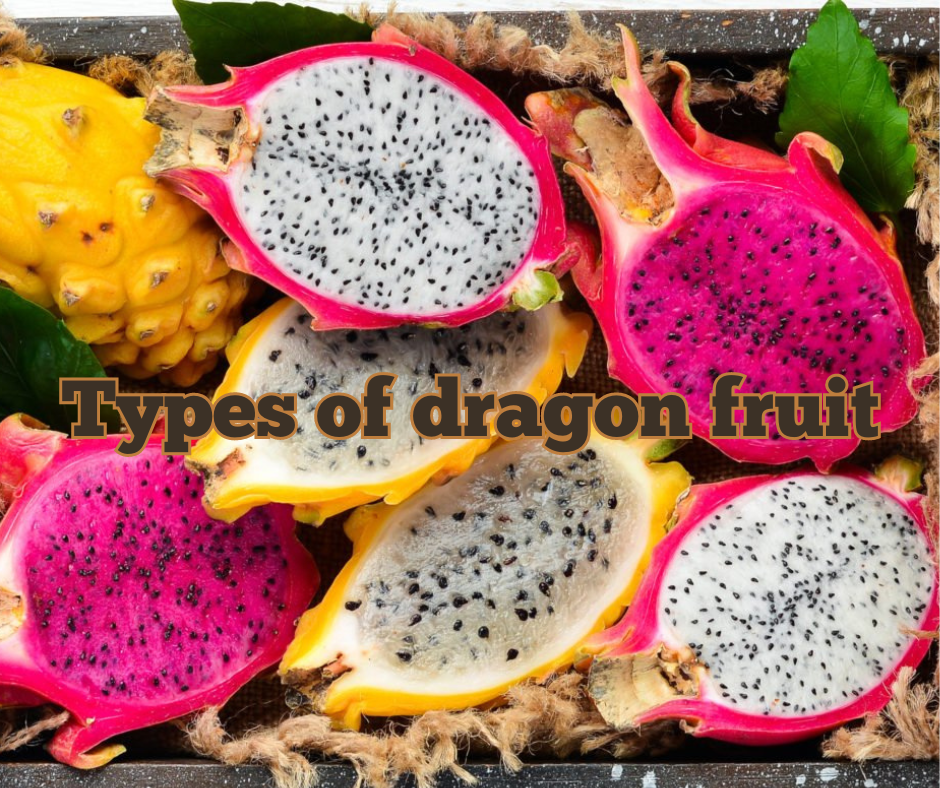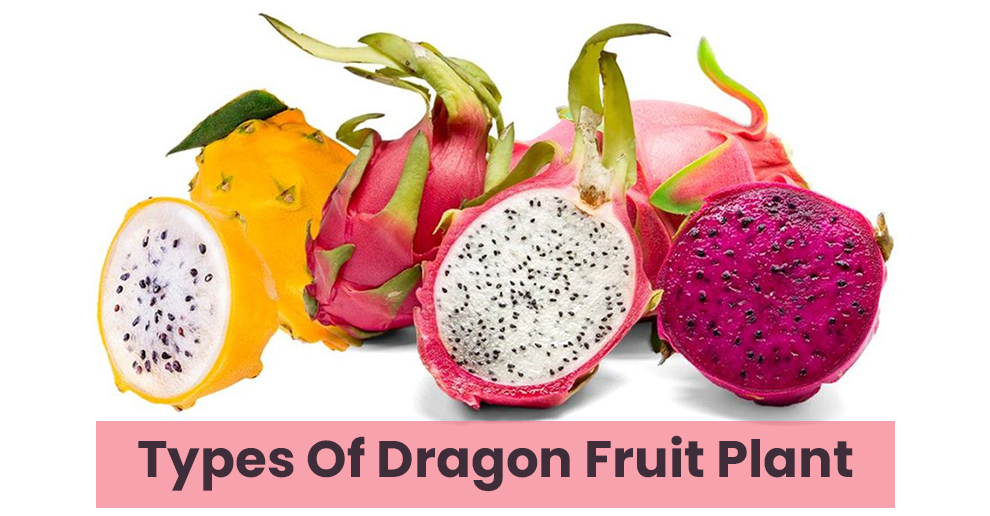Dragon fruit, with its bright colours and juicy meat, is a botanical wonder that shows how diverse nature is in many ways. Investigating types of dragon fruit leads to a trip through an array of shades, tastes, and subtle botanical details. Come along with us as we explore the fascinating world of types of dragon fruit, including answers to queries like “How many types of dragon fruit are there?” as well as information on the many kinds of dragon fruit plants and how to identify dragon fruit varieties. We’ll also explore the types of dragon fruit found in India and clarify the idea of having two kinds of fruit.

Different types of dragon fruit
Dragon fruit comes in a variety of forms and varieties, with the scientific names Hylocereus and Selenicereus. Their distinctive characteristics—which can range from skin tone to meat consistency—allow for identification. Now let’s examine each of the primary varieties of dragon fruit:
- Hylocereus undatus (Pitaya or White-Fleshed Dragon Fruit):
- Unique Qualities: recognizable by its white flesh and vivid pink or yellow skin.
- Flavour Profile: Refreshing, the taste has a hint of sweetness and faint floral undertones.
- Hylocereus Polyrhizus (Red-Fleshed Dragon Fruit):
- Distinguished from its white-fleshed counterpart by its vivid scarlet or magenta flesh.
- Taste Experience: Compared to its white-fleshed predecessor, this cultivar usually has a somewhat sweeter and more prominent flavour.
- Selenicereus Megalanthus (Yellow Dragon Fruit or Pitahaya Amarilla):
- It has a distinctive look due to its bright yellow or golden exterior and white flesh with small black seeds.
- Flavour Notes: Presents a beautiful combination of flavours with a gently sweet taste and tangy undertones.
- Pitaya Blanco Varieties:
- Pitaya Blanco: Known for its crisp, sweet white flesh, it is found in areas with ideal climates.
- Pitaya Roja: is distinguished by its distinct flavour and eye-catching crimson flesh.
- Indian Local Varieties:
- Desert King:
This plant, which is well-liked by Indian farmers, thrives in dry environments and demonstrates toughness and flexibility.
- Crimson Night
Increasingly popular in the Indian subcontinent, this plant is recognised for its deep crimson meat and capacity to adapt to different climes.

These kinds are the basic types of dragon fruit, and they all add to the overall diversity of the fruit. Even though the previously mentioned varieties are well-known, new cultivars and types may be introduced, broadening the range of dragon fruit options, as a result of ongoing cultivation efforts and hybridization techniques. Dragon fruit is a fascinating fruit for producers and consumers alike because of its attractive appearance as well as the wide variety of flavours and textures it offers.
How many types of dragon fruit are there
- Differentiating Between Genera:
Hylocereus and Selenicereus are the two main genera into which dragon fruit variations are categorised. Each of these genera adds to the overall richness of the types of dragon fruit family, including a wide range of kinds.
- Hylocereus Dominance:
Two notable types of dragon fruit stand out within the Hylocereus genus. Pitaya, also known as Hylocereus Undatus, is a species with vivid pink or yellow skin and white flesh. Hylocereus Polyrhizus, on the other hand, has meat that is visually remarkable and has a deep crimson or magenta colour. It also tastes different.
- Selenicereus Elegance:
Selenicereus Megalanthus, often known as Yellow Dragon Fruit, is another intriguing variety found in the Selenicereus genus. It stands out from the other varieties and adds a pop of colour to the dragon fruit range with its bright yellow or golden skin and somewhat sweet flavour.
- Cultivars and Hybridization:
Dragon fruit is a dynamic industry, and continuous cultivation efforts have resulted in the creation of numerous varieties and hybrids. By bringing subtle changes in colour, flavour, and growth patterns, these variants increase the variety within the primary genera.
- Worldwide Enthusiasm:
Dragon fruit is admired everywhere in the world. The variety of dragon fruit varieties is celebrated by growers and enthusiasts around the world, adding to a mouthwatering tapestry of tastes and visual treats. The global curiosity with this unusual fruit is being fueled by continued investigation and the development of new variants.
As we explore the many varieties of dragon fruit, we find not only a wide range of hues and tastes, but also evidence of the creative horticultural techniques that maintain this tropical treasure at the top of culinary and botanical interest.
Types of dragon fruit plants
Dragon fruit is derived from a variety of cactus plant species and is also referred to as pitaya or pitahaya. The two primary species that provide dragon fruit are Selenicereus and Hylocereus. These species come in a variety of cultivars and variants, each displaying unique traits. According to their species, the following are some of the various kinds of dragon fruit plants:

1. Hylocereus undatus, often known as the White-Fleshed Dragon Fruit, is the most common and extensively grown kind.
Although fruit colour, size, and flavour may vary slightly among varieties of this species, they typically have black seeds and white or red flesh.
2. Scarlet-fleshed Dragon Fruit (Hylocereus polyrhizus): This species has certain variations whose flesh is a vivid red or magenta colour.
Within this species, there may be differences in the size, look, and flavour of different cultivars.
3. The Costa Rican dragon fruit, Hylocereus costaricensis, is distinguished by its vivid pink to reddish skin and green scales.
The meat often has black seeds and is crimson in colour.
4. The yellow dragon fruit, or Hylocereus megalanthus, is a fruit produced by this species that has vivid yellow skin and either white or yellow flesh.
It tastes quite sweet and is frequently likened to a kiwi-pear blend.
5. Yellow dragon fruit, or Selenicereus megalanthus: This species is similar to Hylocereus megalanthus in that it has yellow skin and white or yellow flesh.
It has a sweet, crisp flavour.
6. Hylocereus triangularis, crimson pitaya or dragon fruit, is distinguished by its vivid pink to magenta skin and deep crimson or purple flesh.
The taste has an undertone of acidity and is sweet.
It’s crucial to remember that within every species, there may be several cultivars or variations that have been created by selective breeding to have particular qualities like fruit colour, size, and flavour. Furthermore, the features of dragon fruit plants may vary depending on the environment and geographic location. It is advisable to take into account the particular type and how well-suited it is for your growing environment when selecting a dragon fruit plant for cultivation.
How to identify dragon fruit varieties
Dragon fruit varieties can be difficult to distinguish, particularly for people who are unfamiliar with the small distinctions between the many cultivars. To differentiate between several dragon fruit kinds, you can check for a few essential traits. Remember that some of these characteristics could change based on things like growing environments and geographical locations. To identify different varieties of dragon fruit, follow these broad guidelines:
- Fruit Color:
- The colour of the fruit’s flesh and skin is one of the most obvious variations.
- Varieties of dragon fruit can have skin tones ranging from pink and red to yellow.
- Colours of flesh might be white, red, or yellow.
- Fruit Shape:
- Although the majority of dragon fruits are rectangular or oval in shape, some kinds may differ somewhat.
- Observe the general form and any distinguishing characteristics, such as the fruit’s curving or the existence of scales or spikes.
- Scale Arrangement:
- Analyze how the petals or spikes are arranged and look on the fruit’s skin.
- While certain kinds may have a smoother surface, others may have more distinct or noticeable scales.
- Fruit Size:
- There are differences in the size of the fruits produced by different types of dragon fruit.
- Take into account the fruit’s typical size for a certain variety.
- Flower Characteristics:
- While this might not immediately assist in fruit identification, the flower’s features can offer hints.
- Flower forms, sizes, and colors can vary slightly across different types of dragon fruit.
- Growing Conditions:
- Certain climates or growth conditions are more suitable for certain varieties of dragon fruit.
- Take into account the plant’s growing environment and whether it meets the requirements for a specific type.
- Taste and Flavour:
- Although it is impractical to physically identify the type, the flavour and taste can be easily recognised.
- These subtleties help determine which dragon fruit varieties are sweeter or more savoury.
- Origin or labelling:
- The label on the plant might have details about the dragon fruit variety if you bought it from a reliable nursery or other source.
If you are having trouble identifying a particular type of dragon fruit, you might want to speak with knowledgeable farmers, nurseries, or agricultural extension services. They can be able to provide more detailed information based on regional practices and may know the types that are frequently cultivated in your area. Online discussion boards and communities made up of devotees of dragon fruit can also be excellent places to exchange experiences and information about various kinds.
Two types of dragon fruit
- Hylocereus Varieties:
- Perhaps the most well-known type is Hylocereus undatus, often known as Pitaya or White-fleshed Dragon Fruit, which is distinguished by its vivid pink skin and white flesh.
- Fruit of the red-fleshed dragon, Hylocereus polyrhizus: Characterised by flesh that is either deep red or magenta in color, this cultivar provides an eye-catching substitute.
- Selenicereus Varieties:
- Pitahaya Amarilla, often known as Yellow Dragon Fruit, is Selenicereus megalanthus. This type is distinct due to its bright yellow skin and white meat that is dotted with little black seeds.

Conclusion
In conclusion, types of dragon fruit are like artwork: it has bright colours, delicious flavours, and interesting textures. Each type of dragon fruit adds something different and tasty to the scenery of dragon fruit. Hylocereus undatus is mildly sweet; Hylocereus costaricensis is bright red; and Selenicereus megalanthus has a tropical tang.
Dragon fruit lovers and regular people alike are learning more about these unique fruits, which is making people appreciate the types of dragon fruit even more. Dragon fruit is a great example of how nature can delight and surprise our senses. It can be eaten fresh, used in cooking, or grown as a decorative plant.
Table of Contents
To learn more about dragon fruit, click here.
